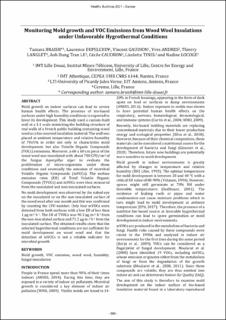| dc.contributor.author | Braish, Tamara | |
| dc.contributor.author | Depelchin, Laurence | |
| dc.contributor.author | Gaudion, Vincent | |
| dc.contributor.author | Andres, Yves | |
| dc.contributor.author | Langlet, Thierry | |
| dc.contributor.author | Le, Anh Dung Tran | |
| dc.contributor.author | Caudron, Cécile | |
| dc.contributor.author | Tinel, Liselotte | |
| dc.contributor.author | Locoge, Nadine | |
| dc.date.accessioned | 2022-01-31T17:52:12Z | |
| dc.date.available | 2022-01-31T17:52:12Z | |
| dc.date.issued | 2021 | |
| dc.identifier.isbn | 978-82-536-1728-2 | |
| dc.identifier.issn | 2387-4295 | |
| dc.identifier.uri | https://hdl.handle.net/11250/2976122 | |
| dc.description.abstract | Mold growth on indoor surfaces can lead to severe human health effects. The presence of bio-based surfaces under high humidity conditions is expected to favor its development. This study used a custom-built wall at a 1:1 scale mimicking the building structure of real walls of a French public building containing wood wool as a bio-sourced insulation material. The wall was placed at ambient temperature and relative humidity of 70±5% in order not only to characterize mold development, but also Volatile Organic Compounds (VOCs) emissions. Moreover, a 60 x 60 cm piece of the wood wool was inoculated with about 700 CFU/cm2 of the fungus Aspergillus niger to evaluate the proliferation of micro-organisms under these conditions and eventually the emission of microbial Volatile Organic Compounds (mVOCs). The surface emission rates (ER) of Total Volatile Organic Compounds (TVOCs) and mVOCs were thus measured from the inoculated and non-inoculated surfaces. No mold development was observed by the naked eye on the inoculated or on the non-inoculated surface of the wood wool after one month and this was confirmed by counting the CFU number. Only four mVOCs were detected from both surfaces with a low ER of less than 1 μg m-2 h-1. The ER of TVOCs was 90.3 μg m-2 h-1 from the non-inoculated surface and 71.2 μg m-2 h-1 from the inoculated surface. The obtained results show that the selected hygrothermal conditions are not sufficient for mold development on wood wool and that the detection of mVOCs is not a reliable indicator for microbial growth. | |
| dc.language.iso | eng | |
| dc.publisher | SINTEF Academic Press | |
| dc.relation.ispartof | Healthy Buildings 2021 – Europe. Proceedings of the 17th International Healthy Buildings Conference 21–23 June 2021 | |
| dc.relation.ispartofseries | SINTEF Proceedings;9 | |
| dc.rights | CC BY 4.0 | |
| dc.rights.uri | https://creativecommons.org/licenses/by/4.0/ | |
| dc.subject | Mold growth | |
| dc.subject | VOC emission | |
| dc.subject | Wood wool | |
| dc.subject | Humidity | |
| dc.subject | Fungal inoculation | |
| dc.title | Monitoring Mold growth and VOC Emissions from Wood Wool Insulations under Unfavorable Hygrothermal Conditions | |
| dc.type | Chapter | |
| dc.type | Peer reviewed | |
| dc.type | Conference object | |
| dc.description.version | publishedVersion | |
| dc.rights.holder | © 2021 The Authors. Published by SINTEF Academic Press. | |
| dc.subject.nsi | VDP::Teknologi: 500 | |

